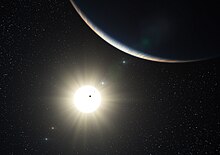HD 10180
| |||||||||||||
 HD 10180 i jej otoczenie, układ planetarny nie jest widoczny (ESO) | |||||||||||||
| Dane obserwacyjne (J2000) | |||||||||||||
| Gwiazdozbiór | Wąż Wodny | ||||||||||||
| Rektascensja | 01h 37m 53,5763s | ||||||||||||
| Deklinacja | -60° 30′ 41,499″ | ||||||||||||
| Odległość | 127 ly 39,4 pc | ||||||||||||
| Charakterystyka fizyczna | |||||||||||||
| Typ widmowy | G1V | ||||||||||||
| Masa | 1,062 ± 0,017 M☉ | ||||||||||||
| Promień | 1,20 ± 0,318 R☉ | ||||||||||||
| Temperatura | 5911 K | ||||||||||||
| Alternatywne oznaczenia | |||||||||||||
|---|---|---|---|---|---|---|---|---|---|---|---|---|---|
| |||||||||||||
HD 10180 – gwiazda typu widmowego G znajdująca się w gwiazdozbiorze Węża Wodnego w odległości około 127 lat świetlnych od Ziemi. Gwiazda HD 10180 posiada układ planetarny składający się co najmniej z 6, a być może nawet z 9 planet[1]. Jest to najliczniejszy znany układ planetarny poza Układem Słonecznym, a być może nawet liczniejszy. Jego konfiguracja jest jednak zupełnie inna, orbity planet są dużo ciaśniejsze.
Zespół astronomów przez sześć lat prowadził obserwacje gwiazdy za pomocą teleskopu o średnicy 3,6-metra należącego do Obserwatorium La Silla, będącego własnością Europejskiego Obserwatorium Południowego. Korzystano z zamontowanego na teleskopie niezwykle precyzyjnego spektrografu HARPS. Pozwoliło to na wykonanie 190 pomiarów prędkości radialnych HD 10180. Analiza pozyskanych danych wykazała niewielkie ruchy gwiazdy spowodowane oddziaływaniem grawitacyjnym okrążających ją planet[2].
Układ planetarny

Planety należące do układu planetarnego HD 10180 mają masy od 1,35 do 64 mas Ziemi, z czego trzy mają masy porównywalne z Ziemią, pięć ma masy zbliżone do masy Neptuna, a najmasywniejsza jest porównywalna z Saturnem. Okresy ich obrotu wokół gwiazdy wynoszą od 1 do 2222 dni, a ich odległości mieszczą się w zakresie od 0,002 do 3,4 jednostki astronomicznej od centralnej gwiazdy. Najlżejsze z planet muszą jeszcze zostać w pełni potwierdzone przez obserwacje zmian prędkości radialnej gwiazdy.
W kwietniu 2012 ogłoszono możliwe odkrycie planet HD 10180 i oraz HD 10180 j[1].
| Towarzysz | Masa (MJ) | Okres orbitalny (dni) | Półoś wielka (au) | Ekscentryczność |
|---|---|---|---|---|
| b (niepotwierdzona) | 0,00424755 | 1,177662 ± 0,000090 | 0,02225 ± 0,00035 | 0,0000 ± 0,0025 |
| c | 0,041217 | 5,75962 ± 0,00029 | 0,0641 ± 0,0010 | 0,045 ± 0,026 |
| i (niepotwierdzona) | 0,006 +0,005−0,0057 | 9,655 +0,022−0,072 | 0,0904 +0,0043−0,0047 | 0,05 +0,23−0,05 |
| d | 0,03696945 | 16,3570 ± 0,0042 | 0,1286 ± 0,0020 | 0,088 ± 0,041 |
| e | 0,07897304 | 49,747 ± 0,023 | 0,2699 ± 0,0042 | 0,026 ± 0,036 |
| j (niepotwierdzona) | 0,016 +0,0186−0,01 | 67,55 +1,28−0,88 | 0,33 +0,017−0,016 | 0,07 +0,12−0,07 |
| f | 0,07519743 | 122,72 ± 0,19 | 0,4929 ± 0,0078 | 0,135 ± 0,046 |
| g | 0,06733159 | 602 ± 11 | 1,422 ± 0,026 | 0,19 ± 0,14 |
| h | 0,20262404 | 2222 ± 106 | 3,40 ± 0,11 | 0,080 ± 0,070 |
Zobacz też
- lista gwiazd w gwiazdozbiorze Węża Wodnego
- lista gwiazd posiadających zidentyfikowane planety
- Kepler-90
Przypisy
- ↑ a b Mikko Tuomi, Evidence for 9 planets in the HD 10180 system, „Astronomy & Astrophysics”, 543, 2012, DOI: 10.1051/0004-6361/201118518, arXiv:1204.1254v1 [astro-ph.EP] [dostęp 2017-01-10] (ang.).
- ↑ C. Lovis, D. Ségransan, M. Mayor, S. Udry i inni. The HARPS search for southern extra-solar planets XXVII. Up to seven planets orbiting HD 10180: probing the architecture of low-mass planetary systems. „Astronomy & Astrophysics”, 2010-08-13. ESO.
Linki zewnętrzne
- Encyklopedia pozasłonecznych układów planetarnych – HD 10180
- HD 10180 w bazie SIMBAD (ang.)
- HD 10180: odkryto najbogatszy dotąd system planetarny – Astronomiczne zdjęcie dnia (pol.)
Media użyte na tej stronie
Plot of the orbits of the HD 10180 system.
Orbit data taken from Lovis et al. (2010), "The HARPS search for southern extra-solar planets XXVII. Up to seven planets orbiting HD 10180: probing the architecture of low-mass planetary systems" available at http://www.eso.org/public/archives/releases/sciencepapers/eso1035/eso1035.pdf
The configuration is given in Table 6 and the orbits are taken to be coplanar, with the planets revolving anticlockwise about the central star. Orbits are depicted as being astrocentric as the true masses are unknown, making the
computation of the position of the barycentres impossible.Autor: ESO and Digitized Sky Survey 2. Acknowledgment: Davide De Martin, Licencja: CC BY 4.0
This image shows a close-up of the sky around the star HD 10180. The picture was created from photographs taken through red and blue filters and forming part of the Digitized Sky Survey 2. The field of view is approximately eleven arcminutes across. The blue and orange halos around the star, and the eight spikes of light, are artifacts of the imaging process and are not real. The remarkable planetary system around this star is far too faint and close in to be visible in this image.
Autor: ESO/L. Calçada, Licencja: CC BY 4.0
This artist’s impression shows the remarkable planetary system around the Sun-like star HD 10180. Observations with the HARPS spectrograph, attached to ESO’s 3.6-metre telescope at La Silla, Chile, have revealed the definite presence of five planets and evidence for two more in orbit around this star. This system is similar to the Solar System in terms of number of planets and the presence of a regular pattern in the sizes of the orbits. If confirmed the closest planet detected would be the lightest yet known outside the Solar System, with a mass that could be only about 1.4 times that of the Earth.



